The next-gen MacBook Pro with Retina Display Review
by Anand Lal Shimpi on June 23, 2012 4:14 AM EST- Posted in
- Mac
- Apple
- MacBook Pro
- Laptops
- Notebooks
General Performance
The Retina MacBook Pro can complete a full boot from power off to usable desktop in just over 17 seconds. It’s a hair faster than last year’s MacBook Airs, a bit quicker than the old SSD equipped MacBook Pro, and night and day compared to any Mac with a hard drive. Four years ago I said that Solid State Drives were the single biggest upgrade you could do for your computer, and it couldn’t be any more true today.
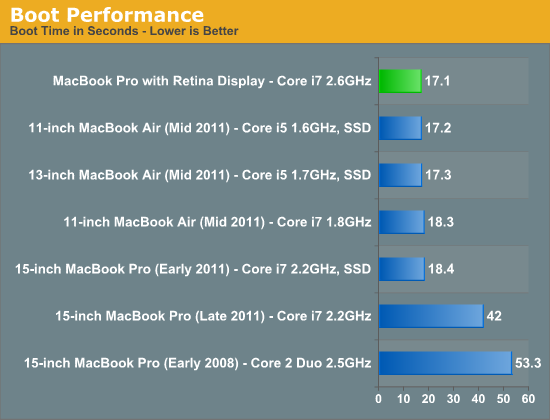
The Retina MBP behaves more like the 3rd gen MacBook Air in how it goes to sleep and wakes up. Both happen virtually instantaneously, and if your battery dies while asleep you don’t get the greyed out screen with progress bar as your environment is restored from disk - it just appears, taking a couple of seconds for the clock to update and everything else to come to life. It’s a small but subtle change that tells you the rMBP is in a distinctly different class. Apple’s tight control over firmware and storage interface help it deliver up to 30 days of standby power, a number I’ll really need to verify one of these days.
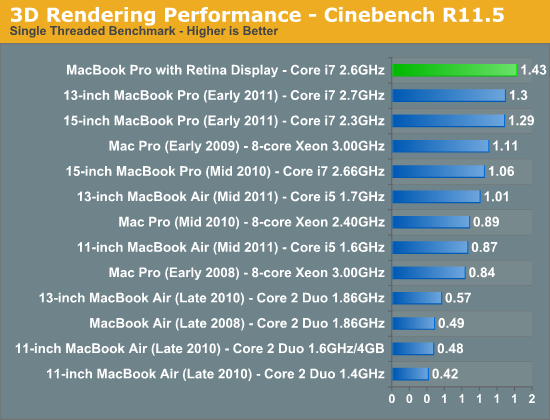
Raw CPU performance is up handsomely over the 2011 MacBook Pros, at least in their standard configurations. The 2.6GHz chip in the $2799 rMBP can turbo up to 3.6GHz when only a single core is active, delivering a 13% increase in performance over the previous generation 2.2GHz part. Compared to the upgraded 2.4GHz Sandy Bridge Core i7 from last year (not pictured) however, I would expect a sub-10% advantage.
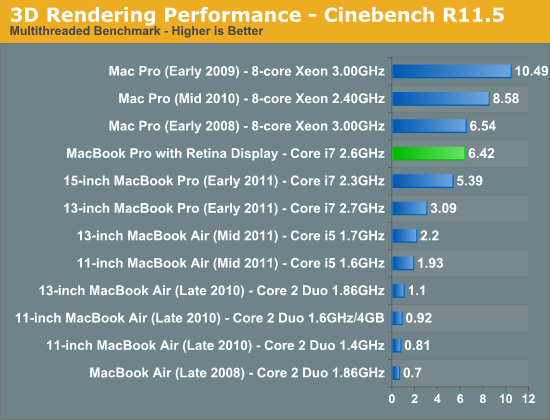
With all four cores active the 2.6GHz chip can run at up to 3.4GHz, which it regularly hits as long as the Kepler GPU stays asleep. The 2.2GHz Sandy Bridge based 2011s we’re comparing to on the other hand can only turbo up to 2.8GHz. Here the advantage is a more tangible 19%, although once again if you are comparing to one of the 2.4GHz parts from last year I would expect notably smaller gains (mid to high single digit percentages). The improved thermal characteristics may allow mobile Ivy Bridge to operate in turbo modes for longer than Sandy Bridge, however I don’t have any data to actually support that claim. That doesn’t mean it can’t happen, it’s just complex to test and model.
While the Cinebench tests are largely CPU bound, many of the following tests are largely influenced by the SSD in the Retina MacBook Pro. Here we see some huge gains, especially compared to older HDD based Macs.
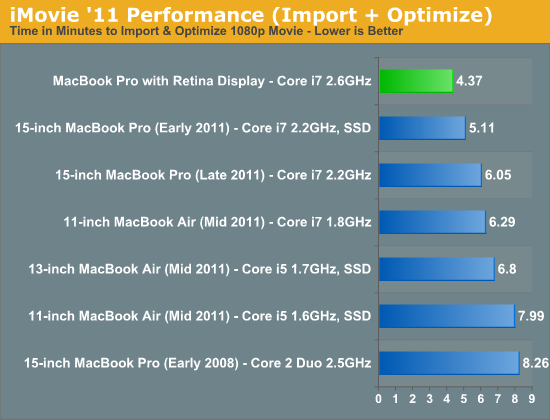
iMovie import time is heavily influenced by disk as well as CPU performance. As a result there are big improvements over both the HDD and SSD equipped 2011 MBPs.

Export time is more heavily CPU bound and here the advantage over the previous generation notebooks is pretty much nonexistent.
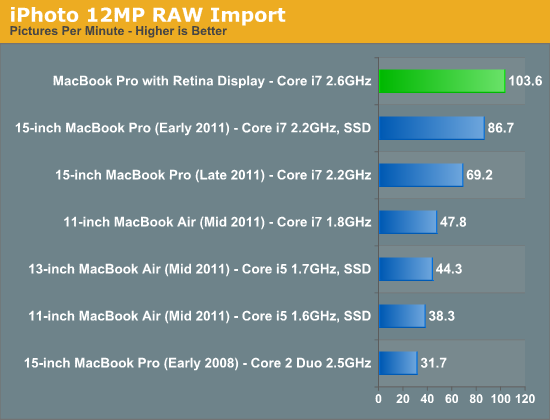
Our iPhoto import test stresses both disk and CPU, giving the rMBP a tangible advantage compared to the SSD equipped 2011 MBP. None of the dual-core or HDD based Macs stand a chance here.

Our Lightroom test continues the storage/CPU dependencies as only the SSD equipped 2011 MBP is able to come close to the rMBP’s performance. There’s not much of a performance advantage here when you compare similarly equipped systems though. Ivy Bridge may have been a good upgrade from a power standpoint, but it doesn’t tell a significantly different performance story in all cases.
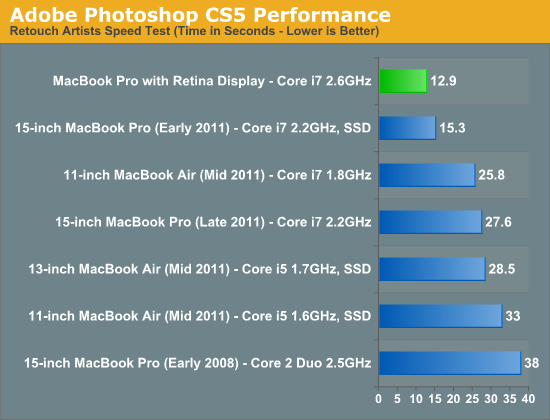
The rMBP cranks through our Photoshop workload fairly quickly. The performance advantages here are likely due to increased memory, a much faster SSD and obvious CPU speed improvements as well.
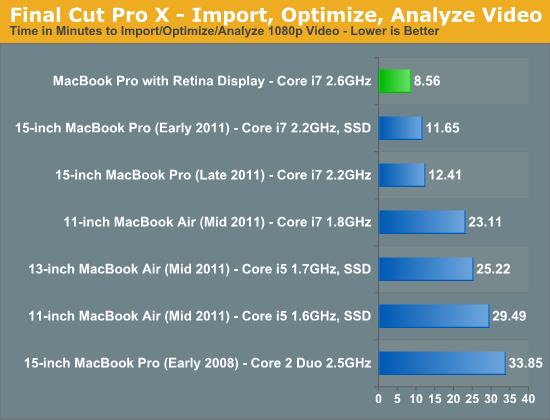
The same holds true for the advantages in our Final Cut Pro X test. As a default configuration the $2799 MacBook Pro with Retina Display is easily the fastest notebook Apple has ever shipped. It’s only if you had an upgraded 2011 model (perhaps with an aftermarket SSD?) that you’ll be unimpressed by the move.
I can’t stress enough how much the new SSD improves the overall experience. It’s just so much faster than what Apple used to ship.










471 Comments
View All Comments
Mumrik - Monday, June 25, 2012 - link
Anand, on page 4 you categorize the rMBP as a consumer device: "At 220 pixels per inch it’s easily the highest density consumer notebook panel shipping today.", but back on page 2 you made a deal of of calling it a pro "appliance" and pointed out that it wasn't a consumer device.
Other than that - this DPI improvement really needs to get moving. It's been so many years and we've essentially been standing still since LCDs took over and the monitor business became a race towards the bottom. IPS, high DPI and native support for it in software PLEASE. 120hz would be nice too.
dwade123 - Monday, June 25, 2012 - link
I don't understand why Apple doesn't take advantage of their lead in Thunderbolt. This machine screams for E-GPU with GTX 670!Spunjji - Tuesday, June 26, 2012 - link
Probably because right now the user experience would be poor. See Anand's comments about sound and USB cutting out when high-bandwidth transfers are occurring. That would be catastrophic mid-game and would definitely lead me to return the hardware as unfit for purpose. Apple have had their slip-ups but they rarely release hardware that is unfit for purpose.inaphasia - Monday, June 25, 2012 - link
Does Apple have some sort of exclusive deal (ie monopoly with an expiration date) on these displays, or can anybody (HP, Asus, Lenovo etc) use them if they want to?wfolta - Monday, June 25, 2012 - link
In recent years, Apple has been the King of the Supply Chain due to Tim Cook. He's now the CEO. I doubt that there will be many retina 15" screens available for Apple's competitors for a year or more.Even if Apple didn't lock up the supply chain, Apple's competitors have been running towards lower resolutions, or the entertainment-oriented 16:9 1920x1080 (aka 1080p), so it will take them a while to pivot towards higher-density displays even if they were growing on trees.
Constructor - Thursday, June 28, 2012 - link
Apple has been paying huge sums (in the Billions of Dollars!) to component manufacturers in advance to have them develop specific components such as this one, even paying for factories to be built for manufacturing exclusively for Apple for a certain time.It is also possible that Apple has licensed certain patents from various (other) manufacturers for their exclusive use which might preclude open-market sales of the same components even after the exclusive deal with Apple is up, because the display manufacturer may not be able to keep using these same patents.
In short: The chances for PC manufacturers to get at them just by waiting for them to drop into the market eventually don't look too good.
After all, none of the other Retina displays have appeared in other products yet. And the iPhone 4 is already two years old.
So either the non-Apple-supplying component manufacturers or the PC builders will have to actually pay for their own development. And given their mostly dismal profit margins and relatively low volumes in the premium segment, I wouldn't hold my breath.
Shanmugam - Monday, June 25, 2012 - link
Anand and Team,Excellent review again.
When is the MacBook Air Mid 2012 review coming? I really want to see the battery life improvement, I can see that it almost tops out at 8Hours for light work load for 13" MBA.
Cannot wait!!!
smozes - Monday, June 25, 2012 - link
Anand states: "[E]nough to make me actually want to use the Mac as a portable when at home rather than tethered to an external panel. The added portability of the chassis likely contributes to that fact though."I work with an external display at home, and given that there are none yet at this caliber, I'm wondering about doing away with the external display and working only with the rMBP. In the past I've always needed external displays for viewing more info, and I'm curious if this is no longer necessary.
Has anyone tried doing away with an external display and just using the rMBP on a stand with a mouse and keyboard? Since the display includes more info than a cinema display, and given healthy eyesight, would this setup be as ergonomic and efficient?
boeush - Monday, June 25, 2012 - link
For several years, I've been using 17'' notebooks with 1920x1200 displays. That resolution had been more than enough for the 17'' form factor; having even such a resolution on a 15'' screen is going overboard, and doing it on an 11'' tablet is just plane bonkers. I don't see the individual pixels on my laptop's screen, and I'd wager neither would most other people unless they use magnifying lenses.I really don't get the point of wasting money on over-spec'ed hardware, and burning energy pushing all those invisible pixels.
I'd rather have reasonable display resolutions matched to the actual physiological capabilities of the human eye, and spend the rest of the cost and power budgets on either weight reductions, or better battery life, or higher computing performance, or more powerful 3G/4G/Wi-Fi radios, etc.
The marketing-hype idiocy of "retina displays" now appears to be driving the industry from one intolerable extreme (of crappy pannels with sup-par resolutions) right into the diametrically opposite insanity -- that of ridiculously overbuilt hardware.
Why can't we just have cost-effective, performance-balanced, SANE designs anymore?
darkcrayon - Monday, June 25, 2012 - link
Reminds me of comments when the 3rd gen iPad screen was introduced. You have a review which both subjectively (from an extremely experienced user) and objectively from tests shows this is the best display ever for a laptop. Yet people ignore all of that and say it's a waste... I think it would be a waste if it didn't actually... You know... Provide a visibly dramatic level of improvement. And its better to make a large jump bordering on "overkill" than to make tiny incremental steps with something like display resolution- fragmentation/etc being what it is,